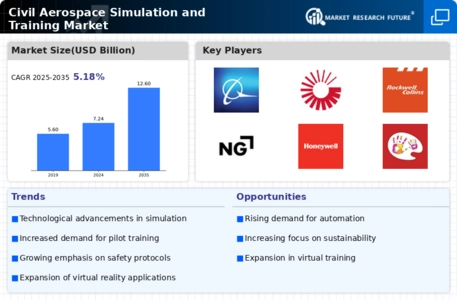The Civil Aerospace Simulation and Training Market has seen significant evolution and competitive dynamics in recent years, fueled by an increasing demand for flight simulation technologies and a rising emphasis on aviation safety and training. As commercial air traffic grows, stakeholders are focusing on enhancing the effectiveness and realism of pilot training systems and simulation services.
This market encompasses a wide range of products, including full-flight simulators, flight training devices, and virtual reality-based training solutions, creating an environment characterized by rapid technological advancements and stringent regulatory requirements.
Companies operating in this market are competing on several fronts, including technology innovation, customer service, cost efficiency, and the ability to deliver customized training solutions to varied clients encompassing airlines, pilot training academies, and military organizations.
Boeing is a prominent player in the Civil Aerospace Simulation and Training Market, leveraging its extensive aerospace expertise to develop advanced simulation technologies. The company has created comprehensive solutions that cater to the needs of commercial airline operators and pilot training organizations.
Boeing's strengths lie in its innovative simulator designs, e-learning modules, and integrated training management systems, which are recognized for their effectiveness in preparing pilots for real-world scenarios. The company capitalizes on its reputation as a leading aircraft manufacturer, which facilitates strong partnerships with airlines and training centers around the world.
Furthermore, Boeing's ongoing investment in research and development helps ensure that its training solutions remain cutting-edge, incorporating the latest advancements in technology and best practices in aviation training.
General Dynamics stands as another key competitor in the Civil Aerospace Simulation and Training Market, renowned for its sophisticated training solutions that improve aviation safety and operational efficiency. The company's commitment to developing highly realistic and adaptable simulation environments enables a comprehensive training experience for pilots and other aviation professionals.
General Dynamics is particularly recognized for its high-fidelity simulation systems, which utilize advanced modeling and simulation technology to replicate diverse flying conditions and scenarios. This focus on quality and realism not only enhances the training process but also helps airlines meet regulatory compliance requirements more effectively.
General Dynamics' strategic partnerships with various aviation stakeholders further enhance its market presence, providing it with the capability to offer tailored training solutions that address the unique challenges of different clients across the aerospace sector.


















Leave a Comment